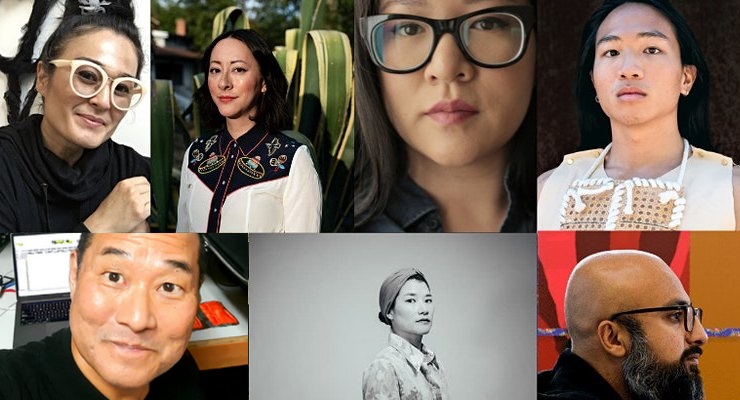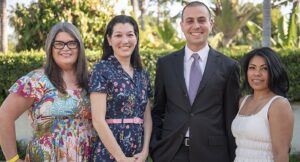
Pasadena’s USC Pacific Asia Museum’s “Intervention: Fresh Perspectives after 50 Years,” brings together seven Asian American artists and scholars who created new artworks that provide new ways to view and engage with the museum’s history and its collection of Asian and Pacific Island art. If you haven’t seen it, time is short; the exhibition ends February 6, 2022.
Asian diasporic artists participating in Intervention include Antonius Bui, Audrey Chan, Jennifer Ling Datchuk, Amir Fallah, Akiko Jackson, Alan Nakagawa, and kate-hers RHEE.
“As we celebrate USC PAM’s 50th anniversary, we look to the future by asking questions and reflecting on our past as it is embodied in the museum’s collection,” Bethany Montagano, Director of USC Museums, said.
“‘Intervention’ offers an opportunity for institutional critique while acknowledging all that the museum has achieved over its 50-year history,” Montagano said. “The exhibition expands on USC PAM’s groundbreaking legacy, which includes being the first museum in North America to mount an exhibition on contemporary Chinese art, as well as the first museum to assemble an exhibition of Aboriginal art in the United States with ‘The Past and Present Art of the Australian Aborigine’ in 1980. We look forward to continuing to present boundary-breaking exhibitions for the next 50 years.”
USC PAM’s Curator Rebecca Hall said the artworks commissioned for the exhibition create new ways to view the museum’s collection and reminds visitors that USC PAM’s history is complex.
“Our public has many ways to consider this story beyond how it is presented in our galleries,” Hall said. “The artists and their fresh perspectives are asking viewers to ponder for who was this collection created, and how does its meaning change when seen through the eyes of our diverse communities.”
About the artists, Antonius-Tín Bui uses both installation and hand cut paper creations to navigate a space often reserved for predominantly white, heterosexual, cisgender people. He employs beauty as a refuge for other marginalized communities. His installation for Intervention will include cut paper portraits and an installation to welcome visitors into the museum space.
Audrey Chan’s research-based projects use drawing, painting, video, and public art to challenge dominant historical narratives through allegories of power, place, and identity. Chan will be mining PAM’s permanent gallery and collection to explore personal connections to Asian art. Utilizing her unique point of view and playful illustrative style, Chan is creating a newspaper for PAM’s visitors, which will be available in the galleries during the full run of Intervention. The newspaper borrows from the Chinese American community newspapers Chan remembers from her youth.
Jennifer Ling Datchuk’s body of work reflects cultural identity as an Asian American woman. She uses her artwork to question the cultural, political, and economic systems that maintain a status quo of sexism, racism, stereotyping, and oppression. For Intervention, Datchuk will be examining and expanding upon representations of women in Asian art.
Amir Fallah’s layered paintings question cultural systems and encourage viewers to contemplate the psychological space of borders, identities, and histories. His large painting for Intervention draws from the USC PAM collection to trace the interconnected histories that are revealed in objects. Through his juxtaposition of historic and contemporary images, he challenges deeply held assumptions about geography and culture by creating new connections.
Akiko Jackson is a visual artist with an emphasis on sculpture and installation. She uses affordable and discarded material specifically chosen to reference cultural memory, time, place, and body. Jackson utilizes materials and process to embrace cultural identity and the preservation of tradition. Jackson’s ethereal installation for Intervention, made with hair, will explore the disconnect people feel in the face of loss.
Alan Nakagawa works from a semi-autobiographical perspective,exploring history and archives to create poignant work tying the present to the past. Nakagawa is the “orphan objects” collection at USC PAM. His compassion for these objects has led him to construct tamashiP, a medium-scaled model of a space vessel that will carry the souls of orphaned objects in the USC Pacific Asia Museum collection into outer space and to a parallel universe where objects with unknown histories can live in peace. The work looks to Japanese funeral traditions, cinema, and science fiction entertainment for inspiration.
kate-hers RHEE works primarily in performance, installation, and participatory interventions, engaging with post-colonial discourses surrounding collecting practices, artifact exhibition and Othering encounters. For Intervention, RHEE is creating a site-specific installation titled “The Postcolonial Afterlives of Han,” a collection of objects dealing with the issues of death and mourning. Focusing on the Korean historical context together with the global pandemic, she combines high and low materials that evoke burial, impermanence, nobility, caste, and the afterlife.
“Intervention” and related public programs aim to generate transformative dialog about developing new institutional methodologies to better engage with the past in order to discover meaning in the present.
To view the schedule of programs, visit www.pacificasiamuseum.usc.edu/
Advanced tickets are required. To purchase tickets, visit:
https://uscpamticketing.as.me/
USC Pacific Asia Museum is located at 46 North Los Robles Ave. in Pasadena. All guests are required to show proof of vaccination and complete a health screening prior to admission. Guests are expected to comply with health and safety protocols. Face coverings worn over the nose and mouth are required except for children two years old or younger. Masks with vents are not acceptable.
For more information, call (626) 787-2680.





